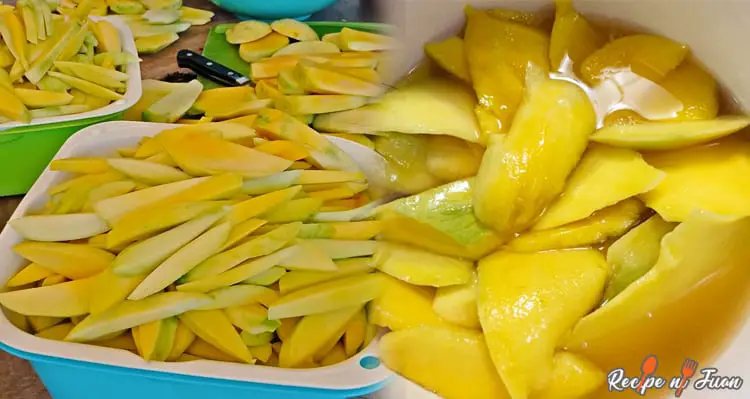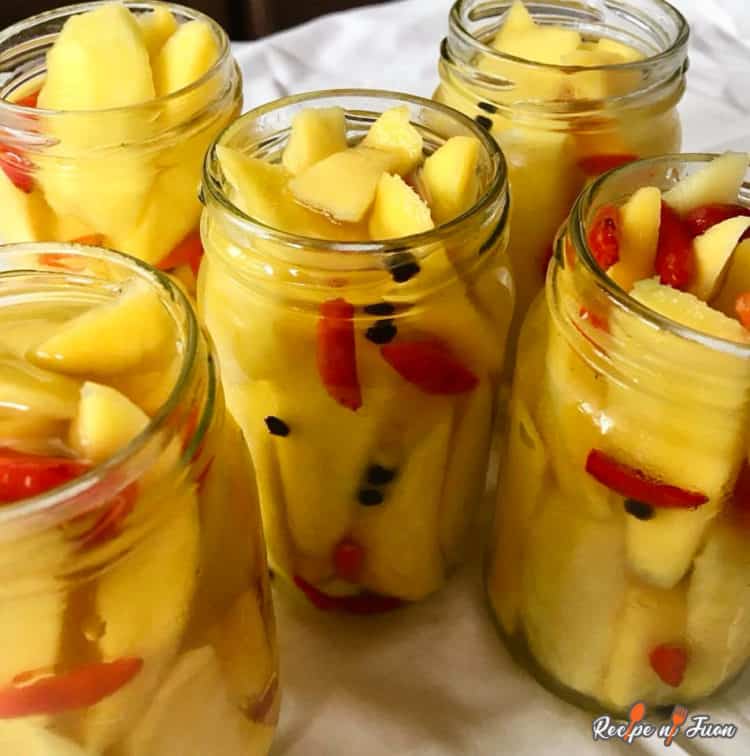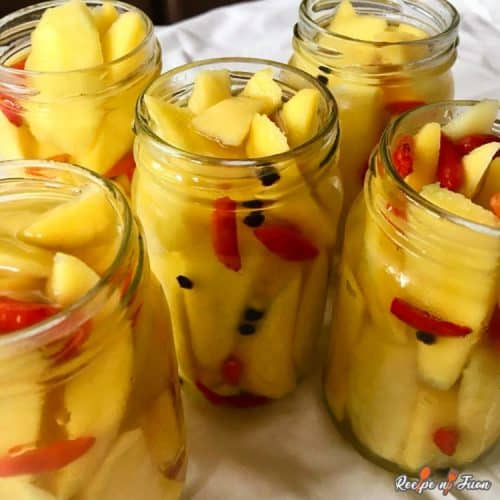Homemade burong mangga: Refreshing Filipino pickled mangoes
Mangoes (or “mangga” in Tagalog) are most abundant during the months of March, April, and May, or during the summer season here in the Philippines. This makes it the best time to make your burong mangga!

This is a pickled mango recipe that’s sold locally in wet markets or even along roadsides near the mango plantations where harvesting goes straight from the tree to the vendor.
But why not try to make it yourself? You’ll have quick access to a refreshing dish, after all!

Check out our new cookbook
Bitemybun's family recipes with complete meal planner and recipe guide.
Try it out for free with Kindle Unlimited:
Read for freeIn this post we'll cover:
- 1 2 types of mangoes to choose to start burong mangga
- 2 Burong mangga preparation
- 3 Homemade burong mangga
- 4 Tips to make perfect burong mangga every time
- 5 What is burong mangga?
- 6 Origin of the dish
- 7 How to serve and eat burong mangga
- 8 Similar dishes to burong mangga
- 9 FAQs
- 10 Pickle some mangoes for a cool treat
2 types of mangoes to choose to start burong mangga
The choices depend on how ripe the mangoes are, which will determine how sour they are:
- Yellow mangoes give the sweetest taste that’s just right for dessert.
- The light yellow to green mangoes are between ripe and unripe. This is the perfect type of mango for making burong mangga.
“Buro” is the local term for fermenting or pickling for most Kapampangans or the natives of Pampanga.
This means that the surplus supplies of mangoes won’t be wasted. They’ll be put to good use instead!

Burong mangga preparation
Burong mangga starts with a good brine solution, which is a mixture of clean water and rock salt. You can also use table salt if there’s no available rock salt, but try not to, as it’ll affect the color and texture of the pickles.
Then the next step is to wash, peel, and slice the mangoes into uniform sizes.
Grab a clean, wide-mouth glass jar, mix all the ingredients inside the jar, and close it with a tight lid. The next step is just to wait and be patient.
Fermenting and pickling need time; usually, a week is just enough to let the process of fermentation take place.

Homemade burong mangga
Ingredients
- 2 medium green mangoes
- 2 tbsp salt
- 1 tbsp sugar
- 3 cups water
Instructions
- Combine water, salt, and sugar.
- Boil your brine solution for 5 minutes and set aside to cool.
- Wash the mangoes thoroughly and peel.
- Cut the mangoes into long flat slivers.
- Arrange the mangoes in a jar.
- When cooled, pour brine solution into your jar.
- Cover and refrigerate for a few days.
Notes
Nutrition
Take a look at this video by YouTuber SarapChannel to see how burong mangga is made:
Burong mangga is a condiment for fried foods such as fried fish or crispy fried chicken.
You can also slice the fermented mangoes, add some slices of onions and chopped tomatoes, and serve them alongside grilled pork or pork barbeque (Filipino style) and some steamed rice.
Tips to make perfect burong mangga every time
Well, pickles are quite an easy thing to make. But if you’ve been in the kitchen for quite a while, you’ll know that it’s the tiny little things that matter to cook something perfect.
Burong mangga is no exception.
That said, the following are some tips you can use to make your pickles taste awesome.
“Eh, it’s just pickles; any mango will work,” says someone who’s never made a great burong mangga.
As this pickle recipe’s main ingredient is mango, choosing fresh, raw, unripe, and firm mangoes is key to obtaining the best texture and flavor.
Therefore, hand pick every mango and see if there are any bruises or soft spots on it. The quality of the mangoes is the last thing you want to compromise on here!
Don’t forget to sterilize the jars
Using sterilized jar(s) for storing the pickles will ensure that no harmful bacteria are introduced to the mixture, saving it from premature spoilage.
Moreover, tight-fitting lids are also important so that no oxygen enters the jar. Since fermentation is an anaerobic phenomenon, limited (or no) oxygen supply will help speed up the pickling process.
Here’s a brief overview of the sterilization process:
- Wash the jars with warm or hot soapy water and rinse them properly.
- Once appropriately cleaned, pour a mixture of vinegar and water into them and let them sit overnight.
- Alternatively, you can make a paste of baking soda and water and apply it inside the jars with the help of a sponge.
- Last but not least, let them dry with the lids off, and then place the jars in a dry place.
- Now they’re ready to store pickles!
Use the right vinegar (if any)
Well, this might seem too bookish, but hey, as I said, the tiny little things make a difference. That said, if you use vinegar instead of water, ensure it has a pH of 5%.
As for which vinegar to use, that’s totally up to you.
I like to use distilled vinegar, as it has a very simple flavor and adds a delightful aroma to the pickles. Besides, it doesn’t discolor the pickles either.
If you want to go a bit off the books and experiment with your recipe, you can try apple cider vinegar. Even though I don’t like it much personally, some people like the tinge of apple in their pickles. If you’rre one of them, then you’ll get a unique type of apple-mango-flavored pickle.
Stay away from iodized salt
Want to keep your pickles looking fresh for a long time? A good way to ensure that is to stay away from iodized salt.
There are 2 reasons for that.
First, it taints the brine with a certain cloudiness that ruins the pickles’ look. Second, it also gives the pickles a funny, unnatural color that makes them look sort of spoiled.
Though the taste will remain the same, you won’t have the best-looking burong mangga with iodized salt.
Add something extra
The original recipe of burong mangga doesn’t contain any extra spices or herbs. Still, it doesn’t mean that you shouldn’t use some!
Adding natural flavor enhancers like garlic cloves, ginger, bay leaves, peppercorns, etc., will give your burong mangga the much-needed spicy kick to take the already great recipe to the next level!
Submerge the mangoes fully
Last but not least, make sure to cut the mangoes in such slices that they’re fully submerged in the brine. The mango slices and amount of brine should be according to the size of the jar.
What is burong mangga?
Also known as pickled mango, burong mangga is a Filipino side dish recipe made by submurging unripe mangoes in brine solution for a certain amount of time.
The brine used in burong mangga is made with water, salt, and sugar. However, most modern versions of the recipe use vinegar instead of water to give extra flavor to the dish.
Although the recipe works with mangoes of every variety as long as they’re unripe, the cultivars traditionally used in the traditional recipe are Carabao and Pico.
Origin of the dish
Among the countless varieties of mango pickles, burong mangga specifically originates from the Philippines. As to when and how? That’s not entirely clear, as there’s minimal recorded information available about the dish.
Let’s just call it a “Filipino take” on the centuries-old food preservation technique that turned out delicious. ;)
How to serve and eat burong mangga
Burong mangga is eaten in a lot of different ways. You can eat it as a snack, serve it as an appetizer, or eat it as a condiment with your favorite meat dishes.
Moreover, you can also serve it with rice dishes to enhance their flavors. The savory-sweet flavor of the pickles blends with everything!
Similar dishes to burong mangga
There are very few fruits and veggies in the world that can’t be pickled, and the list could go on for as long as you and I’d like. But then again, I don’t want to put you to sleep.
Let’s just have a look at some of the best similarly prepared downright delicious dishes.
Papaya atchara
Papaya atchara, or simply atchara, is a Filipino pickle variety. It includes grated unripe papayas and some veggies pickled into a brine made with vinegar, sugar, and salt.
Like burong mangga, papaya atchara is also served as a side dish, snack, and appetizer. It’ss one of the most common varieties of pickles eaten in the Philippines.
Mango pickle
Apart from burong manga, there are other ways of preparing mango pickles in Southeast Asia or Asia. Some other common mango pickles you can try include Indian kadumanga achaar, Pakistani mango pickles, and other Southeast Asian varieties.
One thing you need to know about them? They’re all oily and spicy!
Asinan buah
Asinan buah is a fruit pickle from Indonesia and is similar to burong mangga in preparation, except the brine used is extremely spicy. Though it’s typically prepared with many mixed veggies and fruits, you can simply prepare it with unripe mangoes.
It’s served the same way as any other pickle.
FAQs
Where do you store burong mangga?
Though an unopened bottle of pickles can last up to 2 years at room temperature, once you open the bottle, you must refrigerate it.
Also, per the USDA safety recommendation, any pickles left out for more than 2 hours should be thrown away.
What’s the usual taste of burong mangga?
A well-made burong mangga with the most basic ingredients has a taste that’s a mix of sweet, sour, and salty. However, ones prepared with some extra ingredients might also have a slight spiciness to them.
How do you preserve burong mangga for long?
Keep the mango slices and brine in a well sterilized, air-tight container, away from sunlight, and in a cool and dry place, e.g., a refrigerator. Yes, this seems boring, but it works!
Pickle some mangoes for a cool treat
Pickles are a very widely eaten condiment with almost every dish. And because it has a very basic preparation method and preserves food, cuisines of every region around the world have been experimenting with it with different veggies and fruits.
In the Philippines, the best thing that came out of pickling is the very basic yet delicious burong mangga, a quick mango pickle that brings the best out of every dish it’s sided with. The sweet-savory and salty punch of flavors combined with the characteristic mango flavor are hard not to love.
In this article, I shared a simple burong mangga recipe you can try at home. Moreover, you can also modify it as per your taste with extra flavors if you like, like adding vinegar instead of water, adding a bunch of spices, etc.
I hope this article has been helpful and informative. See you with another delicious recipe guide!
If you want to learn more about burong mangga, then check out this article.
Check out our new cookbook
Bitemybun's family recipes with complete meal planner and recipe guide.
Try it out for free with Kindle Unlimited:
Read for freeJoost Nusselder, the founder of Bite My Bun is a content marketer, dad and loves trying out new food with Japanese food at the heart of his passion, and together with his team he's been creating in-depth blog articles since 2016 to help loyal readers with recipes and cooking tips.
